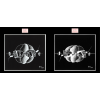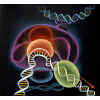Geis Digital Archive
| About | Gallery by Date | Gallery by Name | Irving Geis |
Gallery by Date
Order approximately reflects the order in which the 3D macromolecules were first determined, with the earliest structures first.
 |
Myoglobin FoldGeis illustrated the structure of myoglobin, focusing on the folding pattern of the secondary structure of the protein. Unlike previous myoglobin Illustrations, this painting focuses on the tertiary structure of the molecule rather than the sequence or surface. |
 |
MyoglobinGeis highlights the hundreds of chemical bonds in the lattice of myoglobin. |
 |
Lysozyme (512)Geis illustrates the structure of lysozyme, which was first revealed by X-ray crystallography in 1965 (Blake et al., 1965). The structure of lysozyme was the first to be determined via this method. Geis carefully highlights the interaction between lysozyme and the substrate. This particular illustration appeared on the cover of Scientific American Volume 215, Issue 5 (Phillips, 1966). |
 |
Lysozyme (488)Geis illustrates the structure of lysozyme, the first enzyme structure revealed by X-ray crystallography. In this illustration, Geis carefully highlights the interaction between lysozyme and its substrate (red). |
 |
Ribonuclease SGeis illustrates the structure of the ribonuclease S that highlights the dinucleotide RNA substrate in red and the four disulfide bonds in yellow. |
 |
Hemoglobin SGeis illustrates the hemoglobin s molecule as four nearly symmetrically arranged subunits with a mutation present in the beta chain. |
 |
DeoxyhemoglobinGeis illustrates deoxyhemoglobin in blue, a color associated with the absence of the oxygen molecule. Hemoglobin undergoes a conformational change in the absence of oxygen to produce this conformer. In the center is a red area showing the footprint of the space between the beta chains in the oxygenated state. The beta chains move apart in the deoxygenated state. |
 |
OxyhemoglobinGeis illustrates the hemoglobin molecule in its oxygenated state. |
 |
Intermolecular Contacts in Hemoglobin SGeis paints the intermolecular contacts in hemoglobin S. The lateral contacts are formed by the interactions between residues 66, 73, 80, 83 and 87 of one beta subunit and a mutant beta 6 valine from an adjacent molecule. The axial contacts are made by interactions along the molecule and include residues 16,17,19,22 and 121. Residues 95,47 and 75 interact through contacts between twisted filaments of the molecule. |
 |
Hemoglobin (1000)Geis uses four colors to depict the hemoglobin tetramer structure. The heme groups are shown as white rectangular prisms. A red sphere is in the middle of each of these, representing an iron ion that allows capture of oxygen molecules. Hemoglobin is essential in transporting oxygen in vertebrates. |
 |
DPG-Hemoglobin ComplexGeis illustrates the complex of DPG (2,3-diphosphoglycerate) with hemoglobin as a co-crystal. The charged amino acid residues stabilizing the complex with DPG are drawn in blue. |
 |
HemoglobinGeis illustrates the hemoglobin molecule as four symmetrically arranged myoglobins. Since it is responsible to the transport of oxygen, it can change from an oxygen-binding configuration to an oxygen-releasing configuration in response to the demand for oxygen. |
 |
Transfer Ribonucleic Acid (tRNA)Geis illustrates the structure of transfer ribonucleic acid (tRNA), the nucleic acid that translates the language of the genome into the language of proteins. |
 |
TrypsinGeis illustrates the structure of bovine trypsin, an enzyme that breaks down proteins, which was first revealed by X-ray crystallography in 1971 and further explored in 1974 (Krieger et al., 1974). This illustration was originally published in Scientific American (Stroud, 1984). Trypsin is a protease, an enzyme that catalyzes cleavage of polypeptide chains (Stroud, 1984). Geis' sketch depicts the structure with a ball-and-stick model and displays the sidechains of aspartic acid (Asp102), histidine (His57), and serine (Ser195), known as the catalytic triad. |
 |
Immunoglobulin G (IgG)Geis illustrates the structure of an antibody, immunoglobulin G (IgG), which was first revealed by X-ray crystallography in 1977 (Silverton et al., 1978). His depiction was published in Biochemistry by Donald Voet and Judith G. Voet as Figure 34-15 on page 1099 of the textbook (Voet & Voet, 1990). |
 |
Tomato Bushy Stunt Virus (TBSV)Geis illustrates the structure of tomato bushy stunt virus, which was first revealed by X-ray crystallography in 1978 (Harrison et al., 1978). |
 |
Cytochrome cGeis illustrates cytochrome C, one of the proteins responsible for energy transfer in the electron-transport chain. He highlighted the central heme group in the molecule. Cytochrome C is essential to energy production in the body, and this particular function is highlighted by Geis' choice of framing the central heme as a source of light. |
 |
Cytochrome c (unbound)This illustration depicts the protein, Cytochrome c. The red structures represent the hydrophobic amino acids. The green structures represent the positively charged amino acids. The blue structures represent various types of amino acids. In the center of the picture is a luminous yellow sphere which represents the heme group. The heme group is depicted as such because it plays a crucial role in the function of the molecule. |
 |
Deoxyribonucleic Acid (DNA)Geis illustrates three possible forms of deoxyribonucleic acid (DNA). He highlights the differences between each structure by displaying them in a side-by-side manner. |
 |
B-DNAGeis illustrates B-DNA in blue looking from above, through the double helix. The two bases on top are highlighted in white to distinguish one individual section of the layered scene. |
 |
Z-DNAIn this sketch, Geis illustrates the left handed Z-form of double stranded deoxyribonucleic acid (DNA). Z-DNA is indicated by the zig-zag like pattern of the two strands in relationship to each other. Geis shows a line of symmetry down the middle of the illustration highlighting the helix axis of the molecule. |
 |
DNAGeis illustrates a double helix in his depiction of DNA. He portrays the helices with a soft ribbon structure. The white "box-like" structures represent a base pair in the DNA strand. |
 |
CrambinIn Hendrickson and Teeter's molecular study in 1981, the crystal structure of crambin, a small seed storage protein, was determined based on the location of sulfur atoms in the protein. Using an artistic approach, Geis utilizes bright yellow shading and orange coloring to highlight the importance of these 6 sulfur atoms in this ball-and-stick representation. The backbone of the protein is depicted in blue. |
 |
A-DNAGeis uses a thin ball and stick representation of a section of A-DNA, the more compact conformation of DNA less often seen in biological systems. He draws it from a perspective looking down into the double helix, showing the increase in diameter of the middle of the helix from the B form DNA. |
 |
Carboxypeptidase AGeis depicts the structure of carboxypeptidase A, highlighting the central twisted beta sheet of the enzyme. The enzyme itself cuts polypeptide chains from the carboxyl terminal end. Included in the painting is an orange dot representing a zinc atom at the active site. |
 |
Aspartate Transcarbamoylase (ATCase)In these two paintings of ATCase, Geis portrays the structural transformation between the relaxed state (R-state) and tense state (T-state). The two catalytic trimers, illustrated with tiny specks, are seen on the top and bottom, while the three regulatory dimers, depicted with thin bands, are seen on the sides and in the back. Geis utilizes movement and shading techniques to animate the transformation. The arrows on the sides of the paintings show the directions that the enzyme is rotating in each case. |
 |
MyohemerythrinThe colored print depicts the structure of myohemerythrin, which was first revealed by X-ray crystallography in 1975 (Hendrickson et al., 1975) and further refined in 1987 (Sheriff et al., 1987). Geis's illustration depicts the tertiary structure of the protein, highlighting the four anti-parallel alpha-helices and the presence of mu-oxo-diiron (iron atoms in red and oxygen atom in pink) located within the core of the macromolecule (Myohemerythrin). |
 |
TATA-Binding Protein (TBP)Geis visualizes the TATA-box binding protein (TBP) and its associated proteins that form a preinitiation complex in all eukaryotes for transcribing DNA to messenger RNA. Acrylic painting in collaboration with Dr. Stephen K. Burley (Howard Hughes Medical Institute and Rockefeller University). Illustration copyright by Irving Geis. |
 |
CollagenGeis paints a triple twist pattern in his depiction of collagen. He portrays the chains in a thick, rope-like manner, which reflects the function of the collagen protein in strengthening tendons and muscles in animals. |
 |
Lac RepressorIn this acrylic painting of the lac repressor, Geis characterizes this tetramer representation as "four angry reindeer." Geis' painting depicts the lac repressor with both the tetramerization domain (on the bottom) and the headpieces ("antlers" of the "reindeer"). A complete crystal structure of this tetramer has not actually been determined yet. |
 |
Induced Lac RepressorThis was Geis’ last completed painting. It depicts the structure of a lac repressor monomer, including the tetramerization alpha helix at the bottom, the middle C-domain and N-Domain, and the headpiece domain at the top which binds the lac operator DNA. On the left is the repressed state, which has a high affinity to DNA. On the right is the induced state in which IPTG (isopropyl beta-D-1-thiogalactopyranoside), a artificial inducer, causes a conformational change and reduces the affinity of the repressor for the lac operator, turning on a gene which increases lactose metabolism in bacteria cells. Geis uses a clean tubular style, making it easier to see the conformational change. IPTG causes the gap between the C-subdomain and the N-subdomain to widen. This destabilizes the bonds between the headpieces and the DNA target, shown by multiple shadows emanating from the headpiece residues. |



